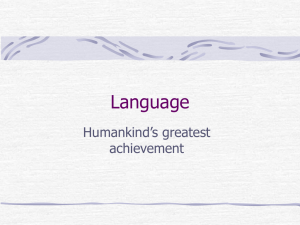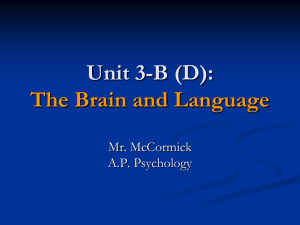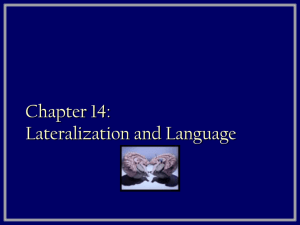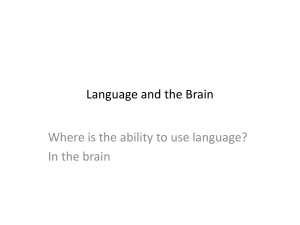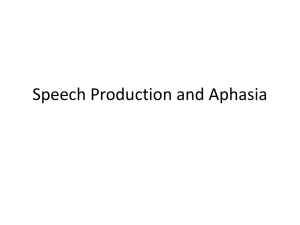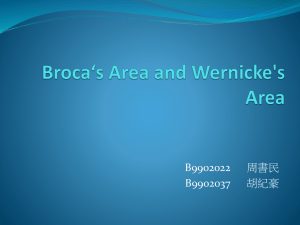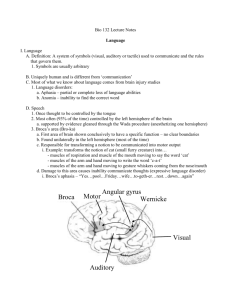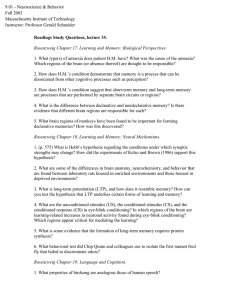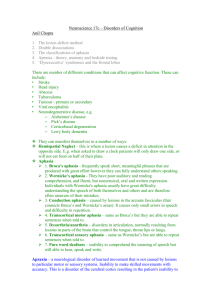ppt
advertisement
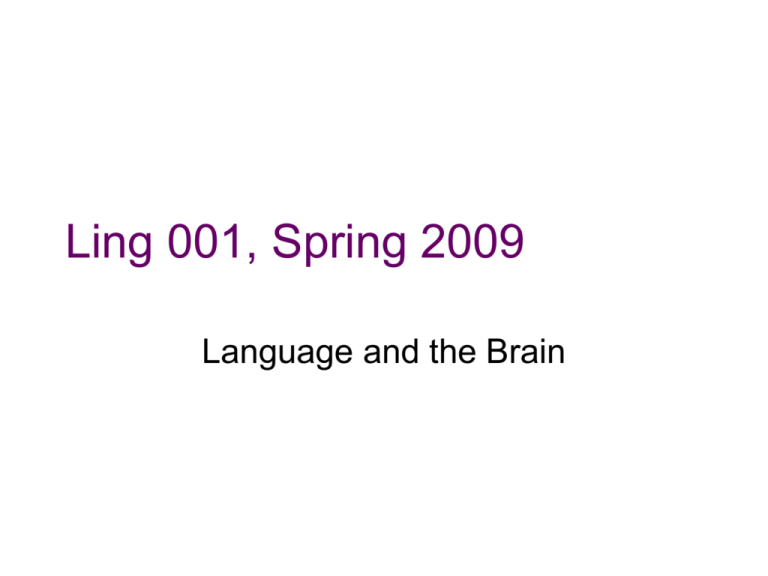
Ling 001, Spring 2009 Language and the Brain Background • Remember some things we have seen thus far: – Abilities in grammar are not directly correlated with general intelligence – Grammars are extraordinarily complex and function in terms of abstract representations and rules – Language acquisition occurs in a biologically determined window – The nature of the evidence available to learners suggests that they need innate structure to ensure acquisition Basic Questions • Concentrating on the idea that humans have an innate capacity for language • Questions: – In what sense are brain areas specialized for language? – Can brain areas be associated with specific subparts of grammar? – What does it mean for brain areas to be specialized in this way? Plan • Basics of the brain • Brain structures relevant for language: the standard/traditional/classic view • Deficit studies: using aphasia as a window on language in the brain • Neuroimaging: using various techniques to look at brain function – Syntax – Sound • Prospects: is the standard view the view of the future? What are the prospects for unifying linguistic studies and brain science? The brain • The human brain: around three pounds Why this is difficult Linguistics Neuroscience Fundamental elements of representation distinctive feature syllable morpheme noun phrase clause dendrites, spines neuron cell-assembly/ensemble population cortical column ? Fundamental operations on primitives concatenation linearization phrase-structure generation semantic composition ? long-term potentiation receptive field oscillation synchronization Connections • Linguistics has its own ontology of representations and computations • Neuroscience has its own ontology, consisting of neurobiological structures etc. • There are no obvious ways of drawing lines between the two ontologies. Right now, we are only at the beginning of asking how the brain might compute language More Detail: Basic structures • The outer layer of the is the cerebral cortex; often thought of as a kind of (folded) sheet • This part of the brain is responsible for most higher cognitive functions • This means that damage (even relatively shallow) to the brain can result in severe impairments in cognitive function Another view The cortex and subcortical structures Hemispheres • The brain is divided into two (roughly symmetrical) hemispheres Connections • The two hemispheres are connected by the corpus callosum Lateralization • Some things that the brain does are lateralized: performed primarily by one hemisphere as opposed to the other • In the case of language, the dominant hemisphere is the left hemisphere for the great majority of righthanded people right-handed left-handed left 96% 70% hemisphere right 4% 15% both 0% 15% The cortex • As mentioned above, he cortex is a kind of folded sheet ; the folded configuration allows for more surface area inside the confines of the skull • Structures: – Gyrus (plural gyri): a bump or convolution – Sulcus (plural sulci): groove or ‘valley’ between gyri Structures • The folds (gyri and sulci) in the brain can be used to identify common anatomical areas of the brain • While some details of brain anatomy differ from individual to individual, the same common structures are found across individuals Lobes The brain has four major lobes: Pink: Frontal Blue: Parietal Green: Temporal Yellow: Occipital Brodmann Areas There are more refined ways of looking at brain areas. One classification into areas is shown here. Space… • When we look at the question of language areas, we (implicitly?) assume that knowing where something happens tells us how something happens • Why would we assume this? • There are some analogies…. Function • How to think about correlations between brains as objects in space, and more abstract representations – Certain areas of the brain are known to be responsible for motor control and for sensory processing – These areas define a kind of map on the cortical surface, where different areas of the cortex correspond to different parts of the body Motor (left); sensory (right) Language areas • According to a picture that has developed over a long period of time, primarily through the study of aphasia, there are two primary language areas – Broca’s Area – Wernicke’s Area • While current research suggests that this original picture is oversimplied in many respects (and wrong in others), it’s the starting point for all current research Broca’s and Wernicke’s Areas Aphasia • Prior to the advent of neuroimaging, brain studies were restricted to cases in which patients showed language disorders after e.g. strokes • Early approaches to characterizing the relationship between lesion (damage) location and behavior concentrated on production versus comprehension Symptoms • Broca’s Aphasia – Agrammatism: halting speech, consisting typically of short utterances – Absence of function words and of e.g. pieces of morphology (e.g. past tense, plural, etc.) – At least at a first glance, relatively good comprehension of language; this is probably misleading, though. Example • Remember: labored speech: – Ah ... Monday ... ah, Dad and Paul Haney [himself] and Dad ... hospital. Two ... ah, doctors ... and ah ... thirty minutes ... and yes ... ah ... hospital. And, er, Wednesday ... nine o'clock. And er Thursday, ten o'clock ... doctors. Two doctors ... and ah ... teeth. Yeah, ... fine. Symptoms 2 • Wernicke’s aphasia – inability to grasp the meaning of spoken words – easy production of connected speech – normally-intoned stream of grammatical markers, pronouns, prepositions, articles, and auxiliaries – difficulty in recalling correct content words, especially nouns (anomia) – words may be meaningless neologisms (paraphasia) – Comprehension impaired Example • Note the nature of the difficulties here: Examiner. What kind of work have you done? -- We, the kids, all of us, and I, we were working for a long time in the... You know... it's the kind of space, I mean place rear to the spedawn... Examiner. Excuse me, but I wanted to know what kind of work you have been doing. -- If you had said that, we had said that, poomer, near the fortunate, porpunate, tamppoo, all around the fourth of martz. Oh, I get all confused. Basic Picture • The picture that emerged in light of these differences focussed on production (impaired with Broca’s aphasia) and comprehension (impaired in Wernicke’s) • As we will see, more detailed examinations reveal that Broca’s aphasics have difficulties with comprehension also-- notably, when the syntax is ‘complex’, in ways which relate to what we have seen in the past A Further Claim • Remember that the basic components of language are – Some set of primitives (e.g. ‘words’) – Rules for putting these together • Sometimes the former is called the Lexicon, and the latter is ‘syntax’ • It appears that these components of language are affected differently in aphasia So… • Another view, which correlates with neuroimaging findings, is that Wernicke’s Area is crucial for Lexical matters, and Broca’s for syntax • What ‘crucial for’ means is a matter for investigation
